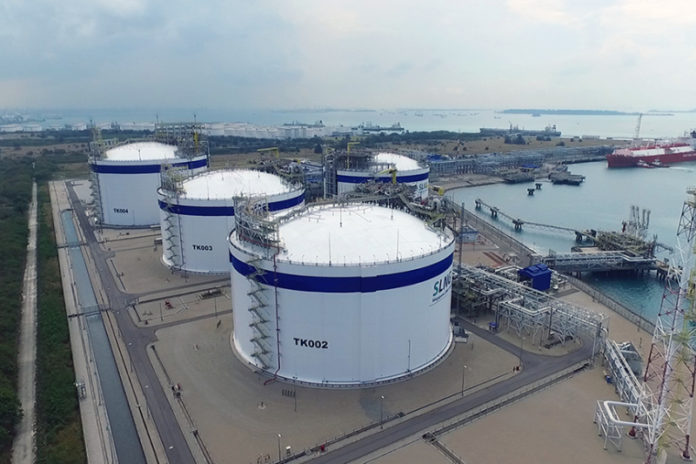When it comes to supporting Singapore’s energy security (i.e. the uninterrupted availability of energy resources at an affordable price), SLNG – or Singapore LNG Corp Pte Ltd – has their work cut out for them. For a country that is about 170 times smaller than New York City, the Southeast Asian nation-state currently ranks 44th in the world for natural gas consumption amid surging global gas prices. Furthermore, more than 95% of Singapore’s electricity is generated from imported natural gas.
Incorporated in 2009, SLNG owns and operates Singapore’s first open-access, multi-user liquefied natural gas (LNG) terminal. SLNG says it is an important part of Singapore’s energy story, playing a role as one of the 4 Switches of Singapore’s Energy Future identified by the Energy Market Authority.
To optimise its myriad business processes, SLNG chose SAP’s S/4HANA Cloud enterprise resource planning (ERP) software as part of its goal to utilise technology and meet its energy security mandate. Frontier Enterprise recently asked Chong Nai Min, Vice President (Information Technology) at SLNG, as well as Eileen Chua, Managing Director at SAP Singapore about SLNG’s digitalisation efforts, S/4HANA implementation, technology objectives, and more.
Benefits of SAP’s cloud ERP

But why use SAP’s S/4HANA Cloud in the first place? What makes it better than similar cloud-based ERP software? According to SAP Singapore’s Eileen Chua, among the main considerations for their ERP are having a scalable architecture; the automation it provides; the embedded analytics, simulation, and predictive decision support for live business operations.
“Companies choosing S/4 HANA Cloud are looking for an ERP system that allows them to adopt new business models, adapt to the quickening business change at speed, have effective integration across internal and external touchpoints, and tap on new technologies like cloud, AI, and analytics to automate the business,” she added.
In deploying S/4HANA Cloud at SLNG, Eileen noted the “diversity of existing platforms” as one of their key challenges. This diversity spanned enterprise asset management, equipment reliability, procurement, and human resources, which required consolidation and further migration of data and operations to S/4HANA Cloud.
“Across these, the team also identified redundant interfaces that were no longer needed,” said Eileen.
Start of the digital journey
SLNG’s Nai Min said their organisation was compelled to digitalise because they see the process as a means to improve how they operate, drive cost competitiveness, and change how they provide value to customers.
“We started mainly with digitising and automating our manual operational processes,” he shared. “We have thus far completed a number of projects that adopt the use of facial recognition, digital twins, predictive maintenance, remote operating vehicles, and data analytics.”
These technologies, said Nai Min, help strengthen their capabilities around physical security and cybersecurity, asset maintenance, and staff productivity.
Before their digital transformation, SLNG used different systems for finance, HR, procurement, and maintenance, with over 100 interfaces across these systems, except for procurement sourcing and tender approval. This resulted in frequent interface errors and the need for manual reconciliations, as well as procurement data that had to be manually entered into and extracted from the sourcing and tender approval systems.
SLNG’s decision to use S/4HANA Cloud helped address these problems.
“The cloud solution is integrated across the various functions and integrates with other external systems via the SAP Cloud Platform Integration service,” Nai Min explained.

The experience so far
SLNG went live with S/4HANA Cloud in July 2021 and their users are still in the process of fully familiarising themselves with the new system. Thus, quantifying the improvements in staff productivity is something that they’re planning at a later stage.
However, Nai Min observed some productivity improvements in terms of having an integrated sourcing system (i.e. Ariba), being able to make approvals for procurement, leave and claims on the go via mobile apps, and eliminating the need for infrastructure maintenance efforts such as vulnerability patching, backups, upgrades, and disaster recovery.
Thus far, the S/4HANA Cloud experience has been relatively smooth for SLNG. Nai Min attributes this to dedicated customer success managers who have continually helped to escalate system and knowledge transfer issues.
“There are still teething issues that we need to resolve, but we are confident that we will sort them out sooner rather than later,” Nai Min remarked. “We chose S/4HANA cloud over the on-premises version because we wanted to leverage cloud capabilities to improve system reliability, scalability, and staff productivity.”
However, SLNG’s digital transformation journey is far from over. The organisation has developed a digital roadmap to guide them towards their business, operation, and workforce goals. “We are still assessing various technologies such as drones, robotics, mixed reality, and artificial intelligence (AI), and will adopt them accordingly if they meet our business and operational needs,” said Nai Min.
















